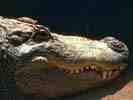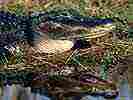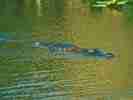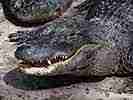
alligators
Wild Animals
alligators
baboons
bears
chimpanzees
crocodiles
deer
dolphins
elephants
foxes
giraffes
gorillas
leopards
lions
seals
sharks
snakes
tigers
whales
wolves
zebras
Pets
dogs
cats
fish
birds
|
This site provides you with the information about alligators, alligator information online, alligator pictures online, alligator photos, alligator pics for kids, images of alligators, alligator description, free alligator info, and more.
If you think that this site is helpful, please recommend your friends to visit our site.
alligators
Alligator (Spanish el lagarto,"the lizard"), common name for two carnivorous reptiles in the crocodilian order. Alligators and their close relatives the caimans have broad, flat, and rounded snouts, as opposed to the longer, sharper snouts of other crocodilians; also unlike other crocodilians, their lower teeth cannot be seen when their mouths are closed. Alligators feed on fish, frogs, snakes, turtles, birds, mammals, and carrion. In North America they are also known to attack humans occasionally. Alligators can survive a wider range of temperatures than other crocodilians, and they are found in more temperate regions. Their breeding season is generally restricted to spring.
When alligators search for a mate they bellow often, perhaps to announce their presence to females and to warn other males to stay away. Unwanted intruders are confronted with ritual gaping, lunging, and hissing, but courtship behavior is sedate. After mating, the male seeks his own territory while the female builds a nest of mud and plants nearby, above flood level. The eggs, from 30 to 60 in a clutch, are covered with mud and vegetational debris. The female stands guard as the eggs incubate in the heat from this decaying vegetation and from the sun. When the eggs are ready to hatch, in about 60 days, the young begin to croak softly within the egg. The female may then assist the young in escaping from the nest and may even carry them in her mouth to the water's edge. The female may remain near her young for a year or more. A young alligator in distress will give a series of sharp croaks that may quickly bring the female to investigate.
Only two species of alligator exist: the Chinese alligator and the American alligator. The Chinese alligator makes its home in the Yangtze River Basin of China. It is more timid and much smaller than the American alligator, seldom exceeding 2.5 m (8 ft) in length, and is considered little threat to humans. The American alligator lives mainly in freshwater swamps, lakes, and bayous in the southeastern United States, but it ranges as far west as the Río Grande in Texas. It is larger, reaching up to about 6 m (about 20 ft) in length, and is potentially dangerous to humans. Attacks occur infrequently, usually in areas where humans have recently encroached on alligator habitat or where alligators have become accustomed to the presence of humans. Hunted for generations both for sport and for its hide, populations of the American alligator dwindled until, in 1967, it was declared an endangered species. Under this protection it made a strong comeback and, little more than a decade later, hunting of the American alligator was again allowed in some states.
Scientific classification: Alligators constitute the genus Alligator, family Crocodylidae. They are sometimes recognized as a separate family, Alligatoridae. The Chinese alligator is classified as Alligator sinensis and the American alligator as Alligator mississipiensis.




|